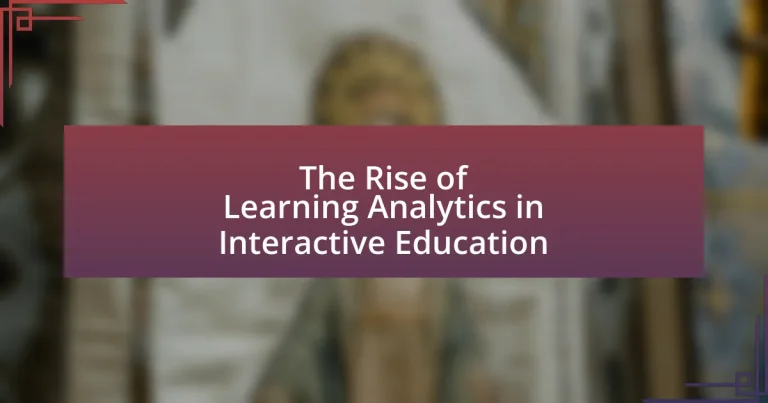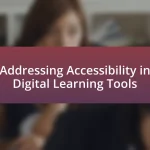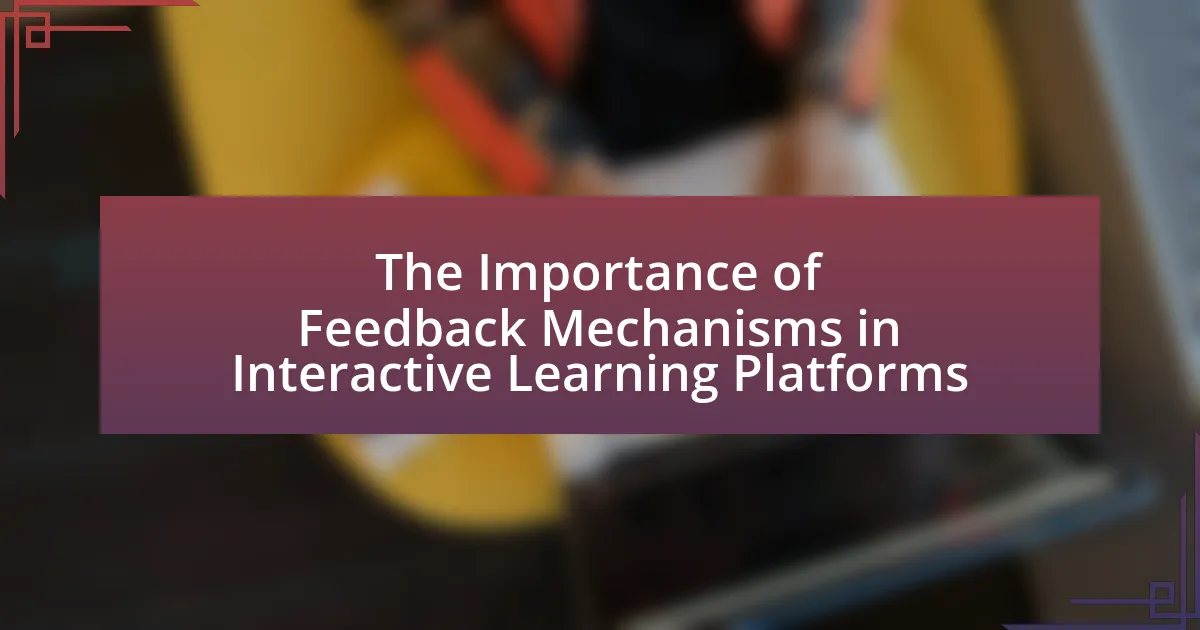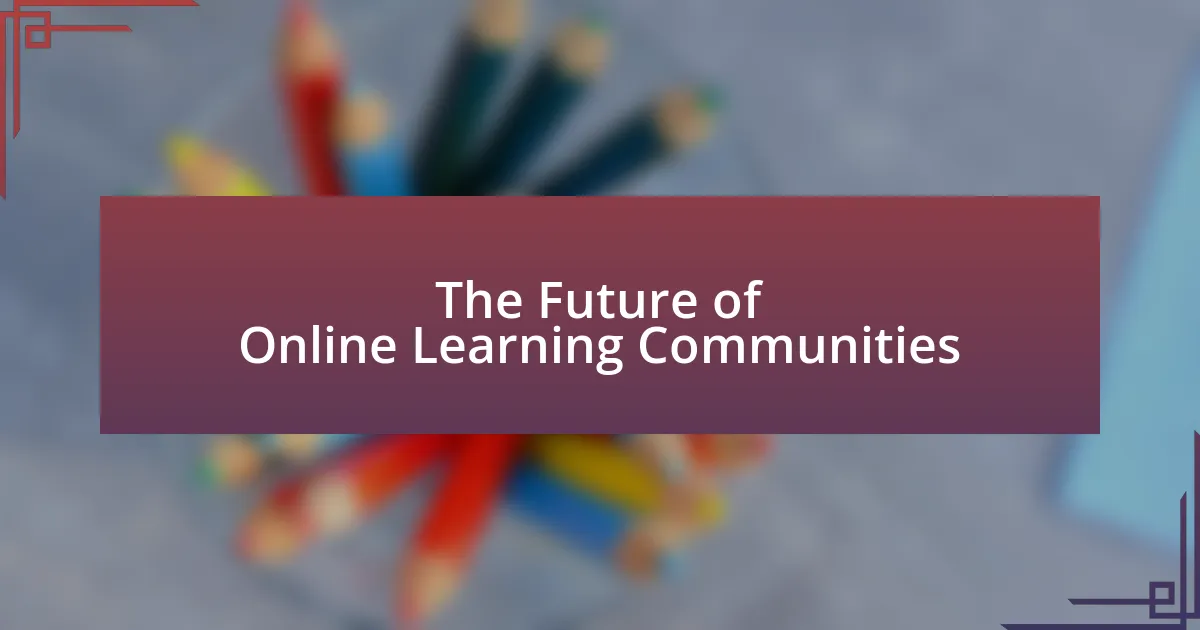Learning Analytics in Interactive Education involves the systematic measurement, collection, analysis, and reporting of data related to learners and their contexts to enhance educational experiences. This article explores how Learning Analytics improves student engagement and retention through data-driven insights, the types of data collected, and the analytical methods employed. It also addresses the ethical considerations, challenges in implementation, and the role of technology in shaping future educational practices. Key components such as data visualization, predictive analytics, and the integration of Learning Management Systems are discussed, highlighting their significance in fostering personalized learning and informed decision-making in educational settings.
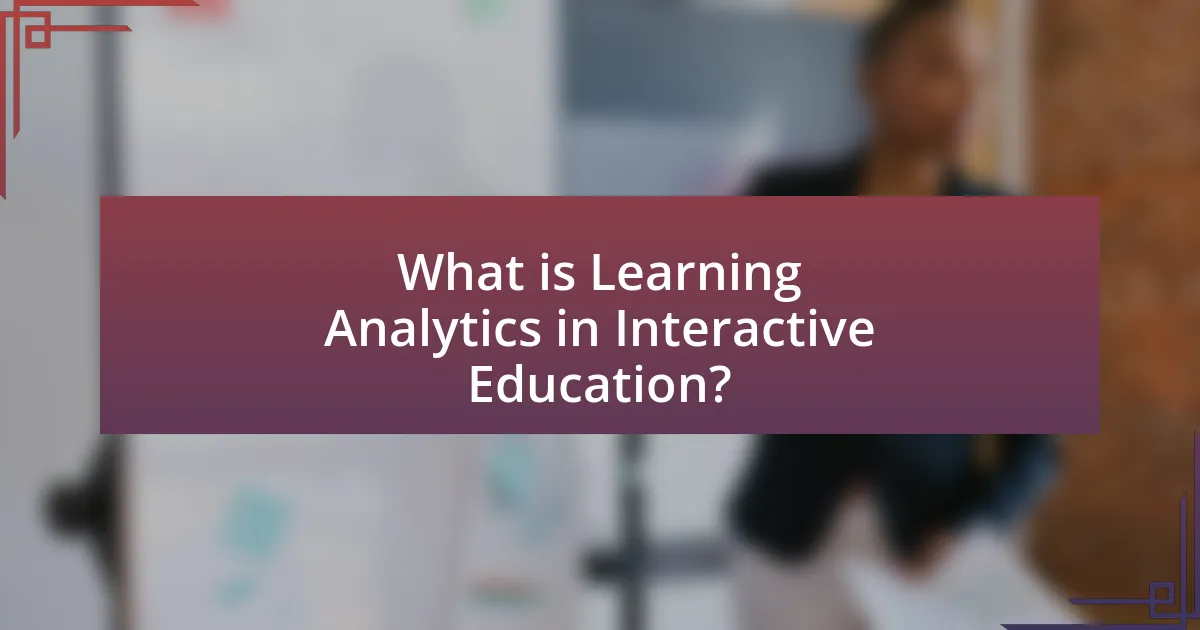
What is Learning Analytics in Interactive Education?
Learning Analytics in Interactive Education refers to the measurement, collection, analysis, and reporting of data about learners and their contexts to understand and optimize learning experiences. This approach utilizes data from various sources, such as student interactions with educational technologies, to inform instructional strategies and improve educational outcomes. Research indicates that effective learning analytics can lead to enhanced student engagement and personalized learning pathways, as evidenced by studies showing that data-driven insights can significantly improve retention rates and academic performance in interactive learning environments.
How does Learning Analytics enhance the educational experience?
Learning Analytics enhances the educational experience by providing data-driven insights that inform teaching and learning practices. By analyzing student performance data, educators can identify individual learning needs, tailor instructional strategies, and improve student engagement. For instance, a study by Siemens and Long (2011) highlights that Learning Analytics can predict student success and identify at-risk students, allowing for timely interventions. This targeted approach not only fosters personalized learning but also enhances overall educational outcomes by ensuring that resources are allocated effectively to meet diverse learner needs.
What data is collected in Learning Analytics?
Learning analytics collects various types of data to enhance educational outcomes. This data includes student demographics, engagement metrics, assessment scores, learning behaviors, and interaction logs from educational platforms. For instance, engagement metrics can reveal how often students participate in discussions or complete assignments, while assessment scores provide insights into their understanding of the material. The analysis of this data helps educators identify trends, tailor instruction, and improve learning experiences, as evidenced by studies showing that data-driven approaches can lead to increased student performance and retention rates.
How is this data analyzed to improve learning outcomes?
Data is analyzed through various methods such as statistical analysis, machine learning algorithms, and data visualization techniques to improve learning outcomes. These methods allow educators to identify patterns in student performance, engagement levels, and learning behaviors. For instance, predictive analytics can forecast which students may struggle based on historical data, enabling timely interventions. Research shows that institutions employing learning analytics have reported a 10-15% increase in student retention rates, demonstrating the effectiveness of data-driven strategies in enhancing educational success.
Why is Learning Analytics becoming essential in education?
Learning Analytics is becoming essential in education because it enables educators to make data-driven decisions that enhance student learning outcomes. By analyzing data from various sources, such as assessments and engagement metrics, educators can identify individual learning patterns and intervene when necessary. Research indicates that institutions utilizing Learning Analytics have seen improvements in student retention rates; for example, a study by Siemens and Long (2011) highlights that data-informed strategies can lead to a 10-15% increase in retention. This evidence underscores the critical role of Learning Analytics in fostering personalized learning experiences and improving overall educational effectiveness.
What trends are driving the adoption of Learning Analytics?
The adoption of Learning Analytics is primarily driven by the increasing demand for personalized learning experiences. Educational institutions are leveraging data to tailor educational content and strategies to individual student needs, enhancing engagement and improving outcomes. Additionally, the rise of online and blended learning environments has generated vast amounts of data, making it essential for educators to analyze this information to optimize teaching methods. Furthermore, the growing emphasis on accountability and data-driven decision-making in education has led institutions to adopt Learning Analytics to demonstrate effectiveness and improve resource allocation. These trends are supported by research indicating that data-informed practices can significantly enhance student performance and retention rates.
How does Learning Analytics support personalized learning?
Learning Analytics supports personalized learning by analyzing data on student performance and engagement to tailor educational experiences to individual needs. This data-driven approach enables educators to identify specific learning patterns, strengths, and weaknesses of each student, allowing for customized interventions and resources. For instance, a study by Siemens and Long (2011) highlights that Learning Analytics can provide insights into student behavior, which can inform instructional strategies and enhance learning outcomes. By leveraging these insights, educators can create adaptive learning environments that respond to the unique requirements of each learner, ultimately improving their educational experience and success.
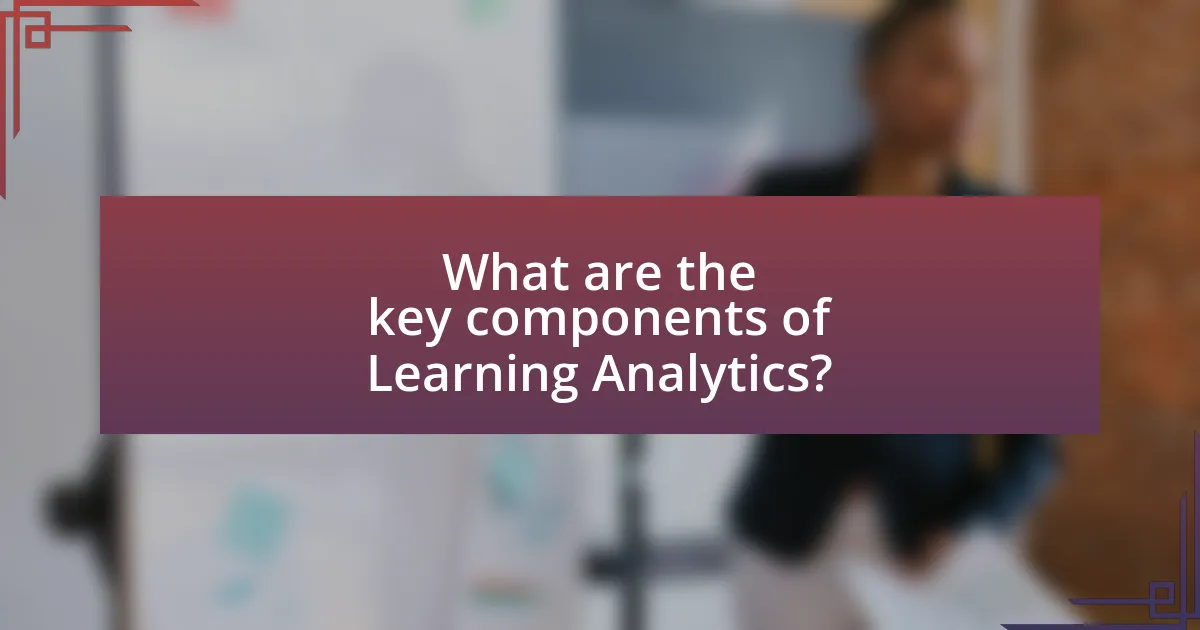
What are the key components of Learning Analytics?
The key components of Learning Analytics include data collection, data analysis, and data visualization. Data collection involves gathering information from various sources such as learning management systems, student interactions, and assessments. Data analysis refers to the process of interpreting this data to identify patterns and insights related to student performance and learning behaviors. Data visualization presents these insights in an accessible format, enabling educators and stakeholders to make informed decisions. These components work together to enhance educational outcomes by providing actionable insights into the learning process.
What technologies are used in Learning Analytics?
Learning analytics utilizes various technologies, including data mining, machine learning, and learning management systems (LMS). Data mining techniques analyze large datasets to identify patterns in student behavior and performance. Machine learning algorithms predict student outcomes and personalize learning experiences based on individual needs. Learning management systems, such as Moodle and Blackboard, integrate analytics tools to track engagement and assess learning progress. These technologies collectively enhance educational insights and improve instructional strategies, as evidenced by studies showing increased student retention and achievement when analytics are applied effectively.
How do Learning Management Systems integrate with Learning Analytics?
Learning Management Systems (LMS) integrate with Learning Analytics by collecting and analyzing data on learner interactions, performance, and engagement within the educational environment. This integration allows educators to track student progress, identify learning patterns, and tailor instructional strategies based on data-driven insights. For instance, LMS platforms like Moodle and Canvas utilize built-in analytics tools to provide real-time feedback on student performance, enabling educators to make informed decisions that enhance learning outcomes. Studies have shown that institutions leveraging LMS-integrated learning analytics report improved student retention rates and academic performance, demonstrating the effectiveness of this integration in fostering a more personalized learning experience.
What role do data visualization tools play in Learning Analytics?
Data visualization tools play a crucial role in Learning Analytics by transforming complex data sets into accessible visual formats that enhance understanding and decision-making. These tools enable educators and administrators to identify patterns, trends, and insights from student performance data, facilitating targeted interventions and personalized learning experiences. For instance, studies have shown that visual representations of data can improve comprehension and retention, as they allow users to quickly grasp key information and make informed decisions based on real-time analytics.
What types of Learning Analytics are commonly used?
Commonly used types of Learning Analytics include descriptive analytics, diagnostic analytics, predictive analytics, and prescriptive analytics. Descriptive analytics focuses on summarizing historical data to understand past performance, while diagnostic analytics identifies reasons behind certain outcomes. Predictive analytics uses statistical models to forecast future performance based on historical data, and prescriptive analytics recommends actions to improve learning outcomes. These types are widely recognized in educational research, as they provide insights that enhance teaching and learning processes.
What is descriptive analytics and how is it applied in education?
Descriptive analytics is the process of analyzing historical data to identify trends and patterns, providing insights into what has happened in a given context. In education, descriptive analytics is applied to assess student performance, track attendance, and evaluate course effectiveness by analyzing data from assessments, surveys, and learning management systems. For instance, a study by the Bill & Melinda Gates Foundation found that institutions using descriptive analytics could improve student retention rates by identifying at-risk students early based on their performance data. This application enables educators to make informed decisions to enhance teaching strategies and improve student outcomes.
How does predictive analytics forecast student performance?
Predictive analytics forecasts student performance by analyzing historical data, identifying patterns, and applying statistical algorithms to predict future outcomes. This process involves collecting data on various factors such as attendance, grades, engagement levels, and socio-economic background. For instance, a study by the Bill & Melinda Gates Foundation found that predictive models can accurately identify at-risk students by examining their past academic behaviors and performance metrics. By leveraging these insights, educators can implement targeted interventions to improve student success rates.
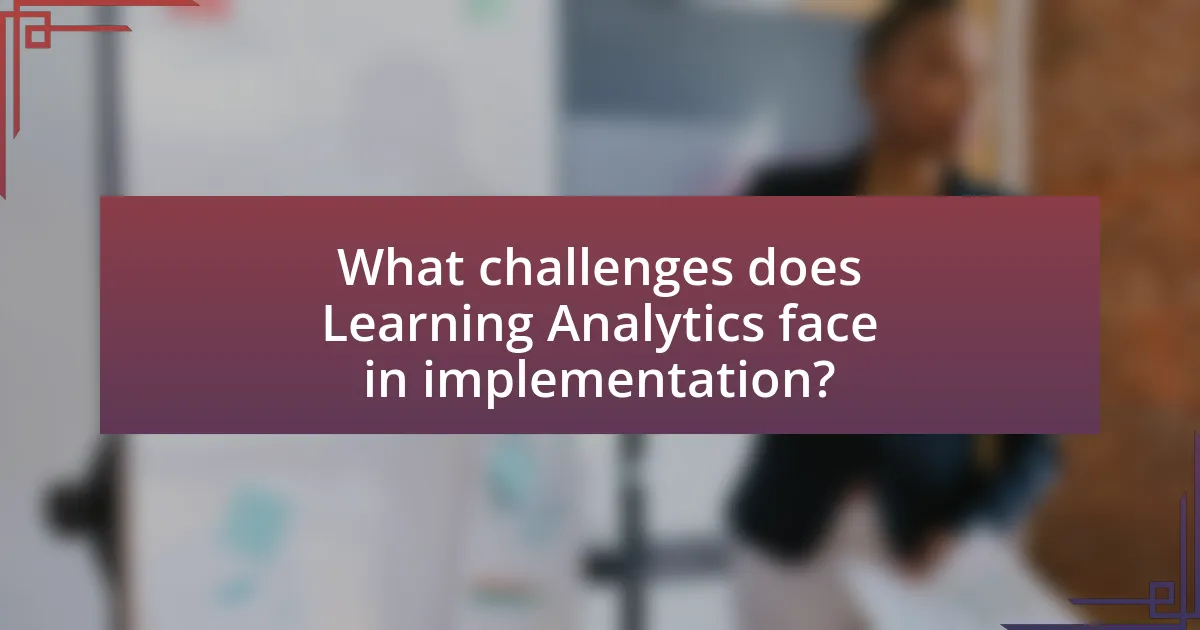
What challenges does Learning Analytics face in implementation?
Learning Analytics faces several challenges in implementation, including data privacy concerns, integration with existing systems, and the need for skilled personnel. Data privacy issues arise as educational institutions must navigate regulations like FERPA and GDPR, which govern the use of student data. Integration challenges occur when learning analytics tools do not seamlessly connect with current Learning Management Systems (LMS), leading to fragmented data and inefficiencies. Additionally, the lack of trained professionals who can analyze and interpret the data effectively hinders the successful application of learning analytics, as highlighted in a report by the Educause Review, which emphasizes the importance of having qualified staff to leverage analytics for educational improvement.
What ethical considerations arise with Learning Analytics?
Ethical considerations in Learning Analytics primarily include data privacy, consent, and the potential for bias. Data privacy concerns arise as educational institutions collect and analyze vast amounts of student data, which may include sensitive personal information. Consent is critical, as students must be informed about what data is being collected and how it will be used, ensuring they have the option to opt-out if desired. Additionally, the potential for bias exists in algorithms used for analysis, which can lead to unfair treatment of certain student groups if not carefully monitored. These considerations are supported by research indicating that improper handling of student data can lead to breaches of trust and legal repercussions, emphasizing the need for ethical frameworks in Learning Analytics.
How can institutions ensure data privacy and security?
Institutions can ensure data privacy and security by implementing robust data protection policies and technologies. These measures include encryption of sensitive data, regular security audits, and compliance with regulations such as the General Data Protection Regulation (GDPR), which mandates strict guidelines for data handling and user consent. Additionally, training staff and users on data privacy best practices significantly reduces the risk of data breaches. According to a report by the Ponemon Institute, organizations that invest in comprehensive data security training can reduce the likelihood of a data breach by up to 70%.
What are the potential biases in Learning Analytics data?
Potential biases in Learning Analytics data include selection bias, measurement bias, and interpretation bias. Selection bias occurs when the data collected does not represent the entire population, leading to skewed results; for instance, if only high-performing students are analyzed, the insights may not apply to lower-performing peers. Measurement bias arises from inaccuracies in data collection methods, such as relying on self-reported data, which can be influenced by personal perceptions and may not reflect actual performance. Interpretation bias happens when analysts draw conclusions based on preconceived notions or expectations, potentially overlooking critical factors that influence learning outcomes. These biases can significantly affect the validity and reliability of insights derived from Learning Analytics, ultimately impacting educational decisions and strategies.
How can educators effectively utilize Learning Analytics?
Educators can effectively utilize Learning Analytics by systematically collecting and analyzing data on student performance and engagement to inform instructional decisions. By leveraging tools that track metrics such as attendance, assignment completion rates, and assessment scores, educators can identify trends and patterns that highlight areas where students may struggle. For instance, a study by Siemens and Long (2011) emphasizes that data-driven insights can lead to personalized learning experiences, enabling educators to tailor interventions that meet individual student needs. This approach not only enhances student outcomes but also fosters a more responsive educational environment.
What strategies can teachers adopt to leverage Learning Analytics?
Teachers can adopt several strategies to leverage Learning Analytics effectively. First, they can utilize data dashboards to monitor student performance in real-time, allowing for timely interventions. Research indicates that real-time feedback can enhance student engagement and learning outcomes, as evidenced by a study published in the Journal of Educational Psychology, which found that timely feedback improved student performance by 20%.
Additionally, teachers can segment students based on learning patterns identified through analytics, enabling personalized instruction tailored to individual needs. A report from the Bill & Melinda Gates Foundation highlights that personalized learning approaches can lead to a 30% increase in student achievement.
Furthermore, teachers should collaborate with data analysts to interpret analytics data accurately, ensuring that insights are actionable and aligned with educational goals. This collaboration can lead to more informed decision-making, as supported by findings from the International Society for Technology in Education, which emphasize the importance of data literacy among educators.
By implementing these strategies, teachers can effectively harness Learning Analytics to enhance educational outcomes.
How can Learning Analytics inform curriculum design?
Learning Analytics can inform curriculum design by providing data-driven insights into student performance and engagement. By analyzing metrics such as grades, attendance, and participation, educators can identify areas where students struggle and adjust the curriculum accordingly. For instance, a study by Siemens (2013) highlights that Learning Analytics enables the customization of learning experiences to meet diverse student needs, thereby enhancing educational outcomes. This data-driven approach allows for continuous improvement in curriculum design, ensuring that it remains relevant and effective in fostering student success.

What is the future of Learning Analytics in Interactive Education?
The future of Learning Analytics in Interactive Education is characterized by increased personalization and data-driven decision-making. As educational institutions adopt advanced analytics tools, they will enable tailored learning experiences that adapt to individual student needs, enhancing engagement and outcomes. Research indicates that institutions utilizing Learning Analytics can improve student retention rates by up to 15% through timely interventions based on data insights. Furthermore, the integration of artificial intelligence will facilitate real-time feedback and predictive analytics, allowing educators to identify at-risk students more effectively. This evolution will ultimately transform the educational landscape, making learning more efficient and responsive to diverse learner profiles.
How will advancements in technology shape Learning Analytics?
Advancements in technology will significantly enhance Learning Analytics by enabling more sophisticated data collection and analysis methods. Technologies such as artificial intelligence and machine learning will allow for real-time processing of vast amounts of educational data, leading to more personalized learning experiences. For instance, a study by Siemens and Long (2011) highlights that the integration of big data analytics in education can improve student engagement and retention by providing actionable insights based on learning patterns. Furthermore, the use of cloud computing facilitates the storage and accessibility of data, making it easier for educators to track student progress and adapt instructional strategies accordingly. These technological advancements will ultimately lead to more effective educational interventions and improved learning outcomes.
What emerging trends should educators be aware of?
Educators should be aware of the increasing integration of learning analytics in interactive education. This trend involves the collection and analysis of data related to student learning behaviors and outcomes, enabling personalized learning experiences. Research indicates that institutions utilizing learning analytics can improve student engagement and retention rates; for instance, a study by Siemens and Long (2011) highlights that data-driven insights can lead to tailored educational interventions that significantly enhance learning outcomes. Additionally, the rise of artificial intelligence in educational tools is transforming how educators assess and respond to student needs, further emphasizing the importance of adapting to these emerging trends.
How might Learning Analytics evolve in the next decade?
Learning Analytics is expected to evolve significantly in the next decade through the integration of artificial intelligence and machine learning, enabling more personalized learning experiences. This evolution will allow educators to analyze vast amounts of data in real-time, identifying individual student needs and adapting instructional strategies accordingly. For instance, predictive analytics can forecast student performance, allowing for timely interventions. Research indicates that institutions employing advanced Learning Analytics have seen improvements in student retention rates by up to 15%, demonstrating the effectiveness of data-driven approaches in education.
What best practices should educators follow when implementing Learning Analytics?
Educators should prioritize data privacy and ethical considerations when implementing Learning Analytics. This involves ensuring that student data is collected, stored, and used in compliance with regulations such as FERPA, which protects student privacy in the United States. Additionally, educators should focus on aligning Learning Analytics with clear educational goals to enhance student outcomes. Research indicates that analytics initiatives linked to specific learning objectives yield better results, as seen in studies by the Educause Review, which highlight the importance of targeted analytics in improving student engagement and performance. Furthermore, continuous professional development for educators on data interpretation and application is essential, as it equips them with the necessary skills to effectively utilize analytics in their teaching practices.
How can educators ensure effective data interpretation?
Educators can ensure effective data interpretation by implementing structured data analysis frameworks and providing professional development focused on data literacy. Structured frameworks, such as the Data-Driven Decision Making (DDDM) model, guide educators in systematically analyzing student performance data, identifying trends, and making informed instructional decisions. Professional development programs that enhance data literacy equip educators with the skills to interpret data accurately, fostering a deeper understanding of how to leverage analytics for student success. Research indicates that schools employing DDDM see improved student outcomes, as evidenced by a study from the Institute of Education Sciences, which found that data-informed practices led to a 10% increase in student achievement in mathematics.
What resources are available for educators to enhance their Learning Analytics skills?
Educators can enhance their Learning Analytics skills through various resources, including online courses, professional development workshops, and academic journals. Online platforms such as Coursera and edX offer courses specifically focused on Learning Analytics, often developed by leading universities. Professional organizations like the International Society for Technology in Education (ISTE) provide workshops and webinars that focus on practical applications of Learning Analytics in educational settings. Additionally, academic journals such as the Journal of Learning Analytics publish peer-reviewed research that can deepen educators’ understanding of the field and its methodologies. These resources collectively support educators in developing the necessary skills to effectively implement Learning Analytics in their teaching practices.
